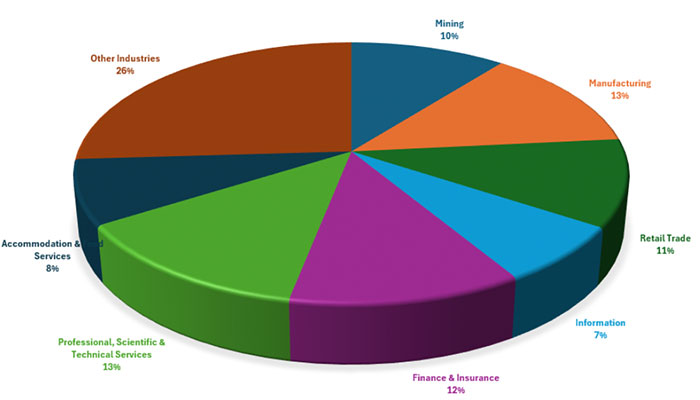A deep dive into Australia’s job market suggests a broadening of the post-pandemic recovery as workers return to work in city offices and postponed construction gets off the ground.

Major employers: New Macquarie Business School data shows workers with skills in building services and construction are in demand.
Job advertisements in 2022 were dominated by the large mining, finance and retail companies, reflecting strong global commodity prices, the rise in home loans and pent-up demand for retail goods.
But in 2023, workers were also in demand by major employers in the early education and specialised retail sectors as well as building service providers.
Last year, total job hiring was spread fairly evenly across the main industries, with mining, manufacturing, retail, information, professional, scientific, accommodation and food service industries each comprising around 10 per cent of total jobs advertised.
Researchers at Macquarie University have been analysing a new tranche of data collected by market intelligence leader LinkUp to identify employment trends and in-demand job skills.
The continued strong employment demand in retail and hospitality sectors despite interest rate rises was one of the more surprising findings.
LinkUp’s real-time data is sourced daily and the database now contains more than 250 million job listings representing 60,000 companies in 195 countries. Some three million advertised jobs in this database are from Australia.
The top 20 private companies (averaging around 5,700 job advertisements a year each) dominated the overall hiring process, placing 35 per cent of all private sector job advertisements in 2023.
The leading employers in 2023 were the mining giant Glencore, construction service companies Downer and Compass, Coles, Domino’s Pizza, and the early childcare providers Goodstart Early Learning and G8 Education.
The commercial banks (CBA, ANZ and Macquarie) rounded out the list of top employers.
Are these large companies the only major employers? Not necessarily. The data shows that while just a few companies account for a substantial portion of all job advertisements, a significant share of job opportunities also comes from the mid-sized and smaller employers.
Outside the biggest 150 hiring companies in 2023, the average number of jobs advertised by the other 2,500 companies in the database was only around 40 but they collectively accounted for almost one-third of all the jobs advertised in 2023.
Spend at your discretion
The new data indicates a return of discretionary spending in the post-Covid period. It’s a trend reflected by increased hiring in retail, strong demand in hospitality, increase work demand in construction and related services, and more luxury brands in the job market.

Where the work is: Job listings in private industries for 2023 data shows the mining, manufacturing and finance sectors were among the biggest employers.
Says Associate Professor Mauricio Marrone, from Macquarie University’s Department of Actuarial Studies and Business Analytics (ASBA), “The continued strong employment demand in retail and hospitality sectors despite interest rate rises was one of the more surprising findings.
“Our analysis of top employers in 2023 shows that discretionary household purchase providers also advertised many jobs, including the hospitality companies Accor Hotels and Marriott, and the retail companies Harvey Norman, Just Group and luxury brands owner EssilorLuxottica.
“This was also despite the large interest rate rises since May 2022, which seems to have continued into 2024 and may indicate that the RBA has more work to do to slow the pace of overall spending and hence inflation pressures.”
Workplace myths
The LinkUp collaboration has unearthed several myths about the Australian job market.
An interesting trend indicated by the dataset is the number of jobs advertised by companies that focus on the relatively unskilled parts of the labour market. For instance, hiring by the retail, travel and other parts of the hospitality sector was still a large share of all jobs advertised.
While the new industries get much of the media attention, industries such as early education, construction, building services and the like are always strong employers as the economy expands.
As team member Professor David Orsmond says: “There is a widespread belief that people with skills associated with artificial intelligence and other advanced technologies are leading the surge in job opportunities, particularly in consulting and information technology companies, and that these technologies are causing huge amounts of disruption in demand for relatively unskilled roles.
“But the data suggests that this shift has not yet happened in Australia. Only Accenture, a data-related company, was in the top 20 employers in Australia in both 2022 and 2023. This could indicate that the rapid advancements in technology have not yet led to a significant change in the types of skills being sought in the Australian job market.”

Safe bet: New Macquarie Businesss School data shows Job opportunities in the early education sector are strong and likely to remain plentiful in the future.
However, further analysis of the data will examine whether the specific skills sought by job advertisers in Australia are changing to reflect these recent technological advancements and in particular understand the role of AI in the future of employment.
Another myth, Associate Professor Marrone adds, is that interest rate rises have significantly slowed down hiring. “Our analysis over the past two years shows that employment demand has remained strong across a broad range of industries, even with substantial interest rate increases since May 2022.”
Career choice
The research has wide-ranging applications, says Dr Ali Amrollahi, another member of the research team at Macquarie University. It helps students make informed career choices, it helps current job seekers, employers wanting to better benchmark their hiring against the trends in the market, policymakers, and universities seeking to shape their curricula around current demands in the job market.
“While the new industries get much of the media attention, industries such as early education, construction, building services and the like are always strong employers as the economy expands,” he says. “Graduate students could consider focusing on these sectors as well for successful careers over the long-term.”
, andare part of a LinkUp/Macquarie Business School collaboration: The New Macquarie University Data Series on Labour Market Trends in a Post-Covid World.








